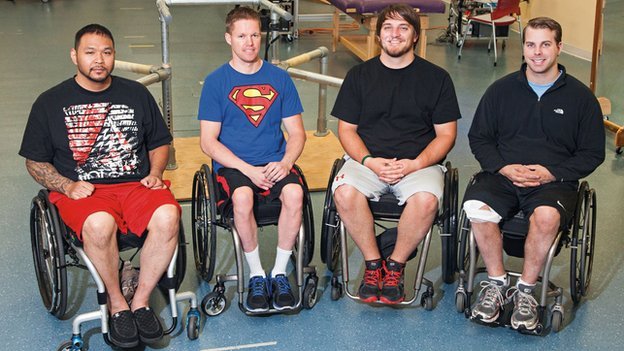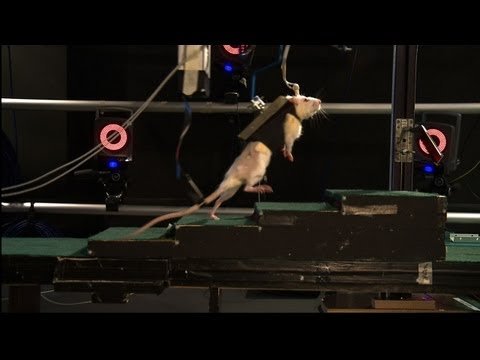A medical team at the University of Louisville and the University of California has reported that four paralyzed men have been able to move their legs for the first time in years after electrical stimulation of their spinal cords.
The men were able to flex their toes, ankles and knees – but could not walk independently.
A report, in the journal Brain, suggests the electricity makes the spinal cord more receptive to the few messages still arriving from the brain.
Experts said it could become a treatment for spinal injury.
The spinal cord acts like a high-speed rail line carrying electrical messages from the brain to the rest of the body. But if there is any damage to the track, then the message will not get through.

The men have been able to move their legs for the first time in years after electrical stimulation of their spinal cords
People with spinal cord injuries can lose all movement and sensation below the injury.
The team has been pioneering electrical stimulation of the spinal cord below the injury.
Three years ago they reported that Rob Summers – a keen baseball player who was paralyzed from the chest down in a hit-and-run car accident – was able to move his legs while supported on a treadmill.
Now three more patients, who had been paralyzed for at least two years, have gone through the procedure and regained some movement.
They were able to control their legs at a precise pace and all but one of them was able to control the force of the movement.
It confirms that function can be restored after paralysis and that Rob Summers’ case was not a one-off.
It is not certain how the stimulation helps, however the researchers believe that some signals are still crossing the injury, but are not normally strong enough to trigger movement.
The electrical stimulation made the lower spinal cord more excitable so it was able to respond when the messages did arrive from the brain.
Dr. Roderic Pettigrew, director of the US National Institute of Biomedical Imaging and Bioengineering, said: “Now that spinal stimulation has been successful in four out of four patients, there is evidence to suggest that a large cohort of individuals, previously with little realistic hope of any meaningful recovery from spinal cord injury, may benefit from this.”
[youtube 2SaacVTkthc 650]
Scientists have shown that paralyzed rats have been able to walk again after their spinal cords were bathed in chemicals and zapped with electricity.
An injury to the spinal cord stops the brain controlling the body.
The study, published in the journal Science, showed injured rats could even learn to sprint with spinal stimulation.
Experts said it was an “exceptional study” and that restoring function after paralysis “can no longer be dismissed as a pipedream”.
In 2011, a man from Oregon in the US was able to stand up again while his spinal cord was stimulated with electricity. Rob Summers had been paralyzed from the chest down after being hit by a car.
Now researchers at the Swiss Federal Institute of Technology say they have restored far more movement in rats which became able to run and climb stairs.

Scientists have shown that paralyzed rats have been able to walk again after their spinal cords were bathed in chemicals and zapped with electricity
The spinal cord of the rats was cut in two places. It meant messages could not travel from the brain to the legs, but the spinal cord was still in one piece.
The researchers then tried to repair the damage. The spinal cord was injected with chemicals which stimulated the nerves in the spine and the base of the spinal cord was electrically stimulated as well. The scientists say they were reawakening the “spinal brain”.
However, this was not sufficient to restore movement. The rats were supported in a robotic harness and were shown a treat which they needed to “learn” to walk towards.
The lead researcher, Prof. Gregoire Courtine, said: “Over time the animal regains the capacity to perform one, two steps, then a long run and eventually we gain the capacity to sprint over ground, climb stairs and even pass obstacles.”
He said: “It is completely unexpected to see this recovery, they walk and climb stairs voluntarily.”
The scientists showed that new nerves were forming across the injury and there were also changes in the brain.
This is not, however, a cure for spinal cord injuries in people.
Prof. Reggie Edgerton, from the University of California Los Angeles, was part of the team which helped Rob Summers stand again.
He said the study was “important” and that it was becoming clear that engaging the brain was the key.
“You’ve got to make the rat want to step, it demonstrates the importance of training and rehabilitation,” he said.
How this works is still unknown. Prof. Reggie Edgerton speculated that “we are activating the spinal cord to a critical level” close to the level which would trigger movement, and a small signal from “the brain pushes it over” leading to movement.


